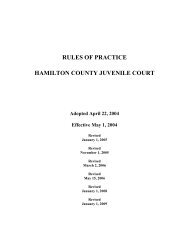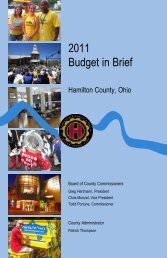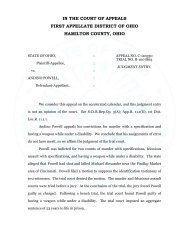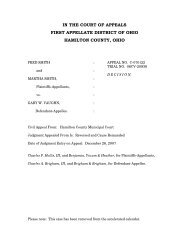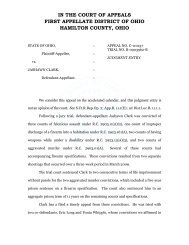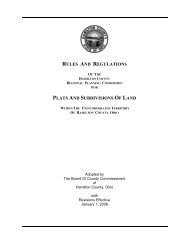Greene v. Cincinnati - Hamilton County, Ohio
Greene v. Cincinnati - Hamilton County, Ohio
Greene v. Cincinnati - Hamilton County, Ohio
Create successful ePaper yourself
Turn your PDF publications into a flip-book with our unique Google optimized e-Paper software.
OHIO FIRST DISTRICT COURT OF APPEALSin the manner in which it demonstrates compliance with the rule. Chan v. TASR, 1st Dist. No.C-070275, 2008-<strong>Ohio</strong>-1439, 10.{11} In the case at bar, the trial court complied with Civ.R. 53(D)(4)(d). In itsjudgment entry, the court stated, “[a]fter hearing oral arguments on August 19, 2009, reviewingthe written memorandum presented by the parties, and considering the evidence and transcriptof proceedings before Arbitrator Joseph A. Alutto of the American Arbitration Association, theCourt finds that Plaintiff-Appellant’s objections are not well taken.”Thus, contrary to<strong>Greene</strong>’s assertion that the trial court had issued a “bare-bones” entry, the judgment explicitlyindicated that the court had relied on the record in finding the objections to be without merit.The court therefore demonstrated that it had fulfilled its judicial function in reviewing therelevant material before finding the objections to be without merit. Accordingly, we overrulethe first assignment of error.The Finding of “Just Cause” to Terminate{12} In his second and final assignment of error, <strong>Greene</strong> contends that the trialcourt erred in overruling his objections. He maintains that the arbitrator exceeded his authorityin determining that he had been discharged with just cause.{13} Because the resolution of disputes through arbitration is favored, judicialreview is limited. Goodyear Rubber Co. v. Local Union No. 200, 42 <strong>Ohio</strong> St.2d 516, 520, 330N.E.2d 703 (1975). Thus, a court cannot vacate the decision of an arbitrator except under thenarrow circumstances set forth in R.C. 2711.10. Id. at paragraph two of the syllabus. Anarbitrator exceeds his authority under a collective-bargaining agreement only if the award doesnot “draw its essence” from the agreement. Id. at 519-520, citing United Steelworkers ofAmerica v. Ent. Wheel & Car Corp., 363 U.S. 593, 597, 80 S.Ct. 1358, 4 L.Ed.2d 1424 (1960).{14} Under the “essence” test, the arbitrator’s award must be confirmed “whenthere is a rational nexus between the agreement and the award, and where the award is notarbitrary, capricious, or unlawful.” Mahoning Cty. Bd. of Mental Retardation and Dev.Disabilities v. Mahoning Cty. TMR Edn. Assn., 22 <strong>Ohio</strong> St.3d 80, 488 N.E.2d 872 (1986),4



